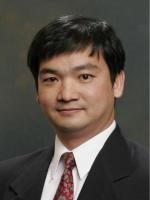May 26 2015
New technology developed at The Ohio State University makes cell phone batteries last up to 30 percent longer on a single charge.
 Chi-Chih Chen
Chi-Chih Chen
The patented circuitry converts some of the radio signals emanating from a phone into direct current (DC) power, which then charges the phone’s battery. This new technology can be built into a cell phone case, without adding more than a trivial amount of bulk and weight.
Some of the inventors, all engineering researchers at Ohio State, are working with a spin-off company to further develop the technology and will launch a Kickstarter campaign in June for market validation and fund development.
“When we communicate with a cell tower or Wi-Fi router, so much energy goes to waste,” explained Chi-Chih Chen, research associate professor of electrical and computer engineering. “We recycle some of that wasted energy back into the battery.”
There are some products newly on the market that harvest stray radio signals to charge tiny wireless devices such as temperature sensors. But the Ohio State invention is many times more powerful and efficient, said Robert Lee, professor of electrical and computer engineering.
“These other devices are trying to harvest little bits of energy from the air,” Lee said. “Our technology is based on harvesting energy directly from the source. They can capture microwatts or even nanowatts (millionths or billionths of a watt), but cell phones need milliwatts (thousandths of a watt) or higher.”
By Lee’s reckoning, nearly 97 percent of cell phone signals never reach a destination and are simply lost. Not all of it can be recaptured, but some can.
“No one can charge a cell phone from the air, but we can reduce power consumption by retrieving some of those lost milliwatts. Think of it as a battery extender rather than a charger,” Lee said.
The work is a natural outgrowth of Chen’s research, which focuses on the design of small antennas and radio frequency energy-harvesting circuitry. Whether he’s developing antennas to be embedded in clothing or a device for detecting and neutralizing buried land mines, the key is designing a circuit that quickly and easily identifies signals of interest, even when the antenna is moving.
The idea of converting radio signals into battery power may not seem straightforward, but the basic technology is almost as old as commercial electricity. It relies on the fact that radio waves are actually just a very high-frequency form of alternating current (AC).
As it happens, the power grid supplies AC, but most devices need DC to operate. For more than a century, electronics manufacturers have installed a special kind of electrical circuit called a rectifier to convert AC to DC. (The chunky, box-like protrusions on modern charging cables are, in part, rectifiers that designers have removed from portable electronics to save weight and bulk.)
To communicate, today’s portable devices broadcast radio signals—that is, high-frequency AC—a portion of which the Ohio State rectifier system captures and converts back to DC. Its trick is to siphon off just enough of the radio signal to noticeably slow battery drain, but not enough to degrade voice quality or data transmission.
Still, there’s a good bit of wasted radio signal to be had. For our convenience, cell phones broadcast in all directions at once; This is the fastest way for a portable device to reach the nearest cell tower or Wi-Fi router.
Chen and his colleagues came up with a system that not only identifies which radio signals are being wasted, but efficiently gobbles up the maximum amount of them that won’t compromise phone function.
It works only when a phone is transmitting—when a person is sending email, texting or talking on a phone.
“If you’re just playing a game offline, it won’t help you,” Chen said.
But phones expend most of their energy in voice and data transfer, so the rectifier helps out when a battery needs it most, slowing power loss by up to 30 percent.
Chen’s co-inventors include Can Koksal, associate professor of electrical and computer engineering; Ness Shroff, Ohio Eminent Scholar in Networking and Communications; and Roland Tallos, a doctoral student. Chen joined with Lee as well as John D. Bair, Rodolfo Bellesi, Flavio Lobato and Will Zell to form Nikola Labs, the company that will develop the technology. Researchers estimate that it will cost around $100.
Next, the engineers want to insert the rectifier system into a “skin” that sticks directly to a phone. Ultimately, however, they would like to partner with a manufacturer to build it directly into a phone, tablet or other portable electronic device.